
by Barry E. DiGregorio Thursday, January 5, 2012
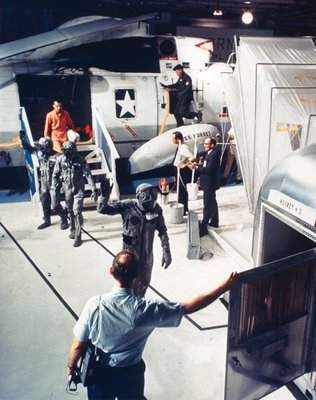
Apollo 11 astronauts in isolation garments. NASA
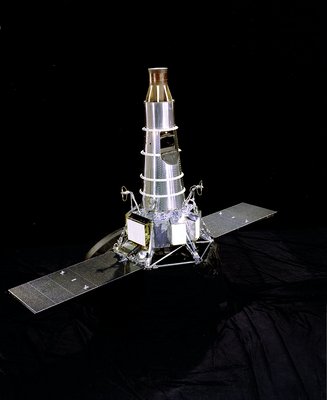
Rangers 6 through 9 made it to the moon, but were unsterilized - thus, their crash landings could have contaminated the moon. NASA
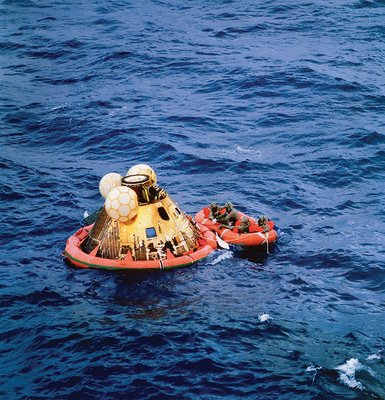
Although Apollo 11 astronauts and their ship were supposed to be quarantined to protect against possible pathogens in moon dust, the capsule door opened into the Pacific Ocean after landing. NASA
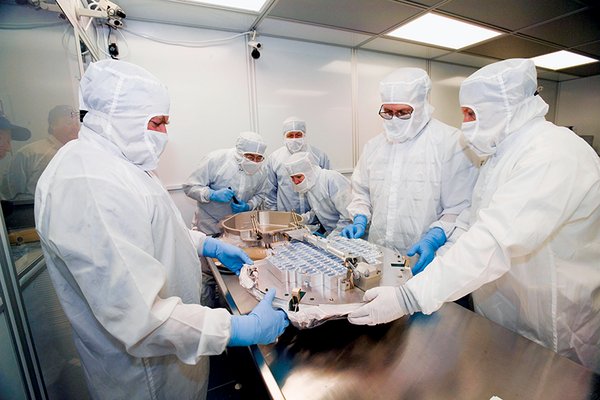
NASA scientists examine dust from comet Wild 2 in a clean room. Pathogens in the dust could still contaminate the scientists: Their eyes (soft, moist tissue) are exposed. NASA
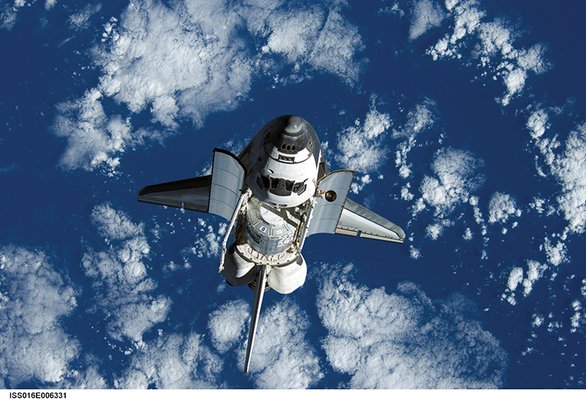
The Space Shuttle Discovery on its way to the International Space Station. NASA
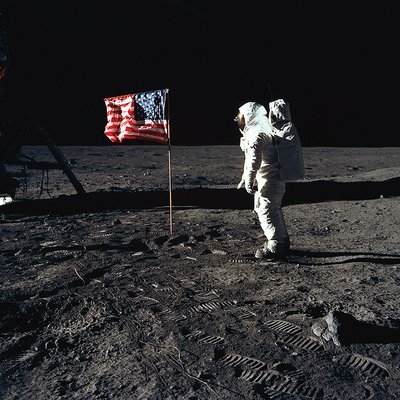
Astronaut Buzz Aldrin stands with the American flag on the moon. The astronauts' footprints are visible in the lunar soil. NASA
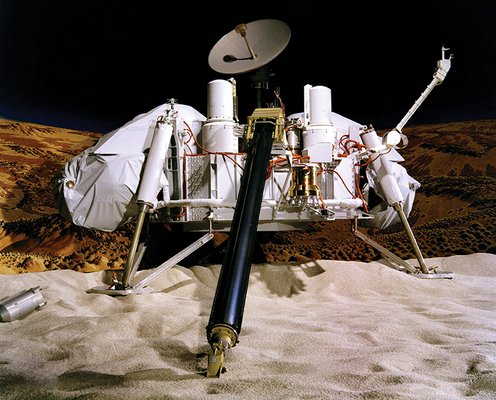
The two Viking landers were the only NASA spacecraft sent to Mars that received a full heat sterilization. NASA
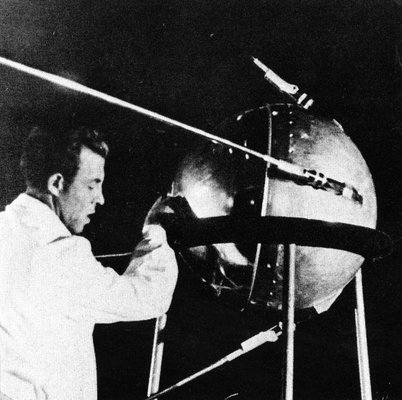
A technician puts finishing touches on the Sputnik 1 satellite in the assembly shop in fall 1957. NASA
Is there life out there? Finding life has been a goal of the exploration of other celestial bodies since humans first imagined leaving our atmosphere — and that life may come in forms we do not immediately recognize. The search itself carries an inherent danger, however: We must not contaminate these pristine worlds with earthly microbes — lest we “rediscover” earthly microbes on a different planet, completely frustrating the science and devaluing the investment in the mission. If celestial bodies like Mars, the moon, comets, and Jupiter and Saturn’s icy moons do harbor microbial life, crash-landing a spacecraft on them could have serious consequences.
International law forbids the terrestrial contamination of other worlds, yet space-faring nations have been sending unsterilized spacecraft to these bodies for more than 20 years. At what cost, we do not yet know. Bringing samples from outer space back to Earth could also have unforeseen consequences. As more missions and more nations get involved in space exploration, who should be governing space travel and sample return is a question that is soon going to need an answer.
There is no universal consensus on what constitutes life, other than its ability to replicate and evolve. Current scientific knowledge suggests that the evolution of life requires a liquid medium, such as water, and a source of energy, such as carbon, various minerals or even harsh chemicals that spew forth from hot hydrothermal vents. Microbiologists are constantly discovering new strategies that microorganisms on Earth use to survive in extreme environments. This leaves open the exciting possibility that microbial life might be found on a variety of celestial bodies — including the moon and the icy moons orbiting Jupiter, Saturn, Uranus, Neptune and perhaps even Pluto — that contain subsurface water-ice and rock. Another idea — the theory of “panspermia” — suggests that comets and asteroids may contain microbes and may have seeded our planet and others with life during collisions.
When the Russians launched the satellite Sputnik at the dawn of the space age on Oct. 4, 1957, scientists knew it would not be long before rockets would carry experiments to the moon and other celestial bodies in our solar system. Because of panspermia, the U.S. National Academy of Sciences (with the help of the International Council of Scientific Unions) began to study ways in which all space-faring nations could peacefully explore outer space without contaminating pristine celestial objects and without bringing back samples that might be harmful to Earth’s biosphere. In 1958, the International Council of Scientific Unions established an international organization called the Committee on Space Research (COSPAR) to work on this and to promote international cooperation on scientific research. This investigation ultimately led to the formal signing of the U.N. Outer Space Treaty in 1967, which, among other regulations, stated that space-faring countries must sterilize their spacecraft to prevent contamination.
COSPAR is in charge of enforcing these spacecraft sterilization guidelines. The committee set standards for the amount of terrestrial microbial spores a spacecraft could contain after decontamination. In 2002, these guidelines were modified after COSPAR determined that Mars' surface is inhospitable, due to a lack of liquid water and high solar radiation. The new rules divided planetary protection protocols into five mission categories; as a result, only those spacecraft that carry life-detection instruments and actually land on celestial bodies will need sterilization. That could reduce the total cost of non-life-detecting missions by 10 percent or more.
But such categorization is short-sighted, says Leslie Tennen, a space law attorney at the Law Offices of Sterns and Tennen in Phoenix, Ariz., who served two terms as a commissioner on the Arizona Space Commission. We don’t have enough information to determine what type of surface may or may not have life or be of sufficient interest to garner appropriate sterilization practices, Tennen says. All celestial bodies are of interest, he notes, and thus missions to these bodies are worth the added expense of thoroughly sterilizing outbound spacecraft.
Identifying who the “planetary protection police” should be — and how such a group should enforce space laws — remain the big, unanswered questions, Tennen says. Ultimately, he says, the planetary protection police has to be the scientific community itself; absent that, governments can get involved. But litigation doesn’t stand a great chance of success, he says.
“It has been very disconcerting and disappointing to observe the willingness of the scientific community to sacrifice the principles of planetary protection in favor of conducting more or cheaper missions,” Tennen says. “Planetary protection requirements should be welcomed by scientists, for the simple reason that they promote integrity of results of examination and experimentation,” he adds. “It seems difficult to understand the rationale that permits contaminated spacecraft to land on celestial bodies on which we have literally just scratched the surface in the search for the origins of life.”
The roots of the concern over space contamination go back before the Outer Space Treaty was even signed. In 1961, NASA began sending a series of nine unmanned spacecraft, called Rangers, to the moon. The Rangers were intended to take extreme close-up images of the moon’s surface to see if it was solid or a sea of dust, and would then intentionally crash on the moon. COSPAR recommended that the first five Ranger missions be given the most comprehensive sterilization at the time, which included washing all the spacecraft hardware and components in germicidal solutions and then baking them in a large oven until the “bioburden” was reduced to 30 spore-forming bacteria or fewer.
However, the first five Rangers failed, some during takeoff and some in space. The blame was placed on the baking of the spacecraft in the oven, which some engineers said might have ruined some of the electronic components. So the rest of the Rangers — each containing hundreds of thousands of terrestrial microbes — were sent without sterilization. Other lunar probes followed in preparation for Apollo. None were sterilized.
When the manned Apollo missions were announced, all ideas of preventing any further contamination of the moon went out the window. We humans carry billions of bacteria in our skin, hair and internal organs. The new problem was that no one knew if the moon dust, soil or rocks brought back by the Apollo missions might harbor any dangerous microbes.
So NASA set up a quarantine protocol for the Apollo 11 return, the first manned mission to land on the moon. The plan was to have the Apollo 11 capsule lifted out of the sea by a helicopter and brought onto the deck of an aircraft carrier where it would be placed under a biohazard tent and washed down with a potent germicidal solution. At that point, the astronauts would go to a quarantine trailer in biohazard suits where they would spend up to 21 days while the crews’ blood samples were analyzed and condition observed. Animal and plant tests would also be performed on lunar samples during this quarantine period to make sure Earth life was not in danger of any infection.
Ironically, even though the astronauts were quarantined for three weeks following their return, any pathogens the moon dust had carried would have been released to the ocean and atmosphere the minute the Apollo 11 return capsule door opened into the Pacific to allow the astronauts out. Thankfully, moon dust did not seem to contain pathogens.
The twin NASA Viking Landers of 1976 are the only spacecraft sent to another planet to search for life using microbial life-detection instruments. Before leaving Earth, both Viking Landers underwent a stringent set of sterilization procedures designed to limit the amount of terrestrial spores to fewer than 30. The spacecraft were then baked for 30 hours. Each lander had identical instrumentation and was sent to different locations on Mars to look for life. They carried three miniature biology laboratories and a gas chromatograph mass spectrometer instrument to look for organic material in the soil. Although the mass spectrometer instruments failed to detect organic material in four tests, the three biology instruments all got positive reactions. However, in the end, because of the mass spectrometers’ negative results for organics, the biology findings were considered negative.
However, two members of the original Viking biology team, Gilbert V. Levin (then president and CEO of Biospherics Inc. in Beltsville, Md.) and Patricia Ann Straat (then of the National Institutes of Health in Bethesda, Md.), who designed the Viking Labeled Release biology experiment, think their instrument did find microbial life on Mars. It has taken Levin and Straat decades of hard work in the laboratory to counter all the other theories suggesting Mars is a dead world. “In 1997, I became convinced that the Viking [Labeled Release experiment] detected living microorganisms in the soil of Mars, and published that conclusion. Since then, all pertinent findings, on Mars and on Earth, have reinforced my conclusion,” Levin says.
If Levin is right, “the discovery of a second genesis of life would have profound philosophical and practical implications,” says Chris McKay, an astrobiologist at the NASA Ames Research Center in Moffett Field, Calif. “From a practical point of view, the ability to compare and contrast earthly biochemistry with an alternative type may give us deep insights that span across medicine, agriculture, microbial control and all areas of practical science,” he says. And from the philosophical perspective, he adds, we can answer the question of whether there is life in the universe. After all, he says, if life originated twice here in our own solar system, it is a pretty safe bet that the universe is full of life.
All NASA landers and rovers sent to Mars since Viking have launched unsterilized — thus carrying hundreds of thousands of microbial spores within them — all because NASA declared Mars a lifeless planet and therefore these probes did not carry life-detection instruments. Whether this would affect Martian life — if there really is any — is debatable. Most scientists think that ultraviolet light from the sun would kill any earthly microbes on Mars’ surface within minutes because the planet lacks an atmosphere. But the microbes inside the landers and rovers could possibly survive and maybe even escape during dust storms and spread.
And indeed, recent research by Andrew C. Schuerger — a microbiologist who studies plant pathology at the University of Florida in Gainesville and one of four permanent faculty members at NASA’s Kennedy Space Center Space Life Sciences Lab who works on planetary protection issues — suggests that a global dust storm would only permit about a quarter of total ultraviolet light to reach the surface. Thus, Schuerger says, “the time for inactivating all exposed bacteria on a spacecraft might change from one hour to four hours; still well within the time of a single sol [day] on Mars.”
Meanwhile, in 2003, the Mars rovers Spirit and Opportunity were launched, reaching Mars in January 2004. Neither was sterilized, and both have been roving the red planet for more than five years now.
In 2002, NASA’s Mars orbiter Odyssey found evidence of subsurface ice in Mars’ northern hemisphere. Three years later, in 2005, NASA convened a committee to consider “Special Regions” on Mars, areas where subsurface ice exists and might allow terrestrial microbes to take hold and spread. However, within the last year or two, orbiters have found more regions of subsurface ice, even near the planet’s equator. It now seems the entire planet might have subsurface ice covered by a few meters or less of rock and soil. Is the entire planet now a special region?
This highlights the inadequacy of our current approach to planetary protection, Tennen says. “Every celestial body should be presumed to be of interest in the search for life — in other words, a special region — until conclusive evidence to the contrary is obtained. Even a sterile body is important in the search for the origin of life.”
Russia is preparing to launch a spacecraft in October to the Martian moon Phobos. The spacecraft, Phobos-Grunt, will study the Martian atmosphere as it orbits Mars and then head to Phobos, where it will sample the atmosphere, land on the moon’s surface, scoop up subsurface samples and return them to Earth 34 months later, says Alexander V. Zakharov, chief scientist at the Space Research Institute of the Russian Academy of Science and project scientist of the Phobos soil project. By collecting samples from Phobos and returning them to Earth, “Phobos-Grunt is a rehearsal for an eventual Mars sample return,” he says.
The mission will also carry and return to Earth an experiment designed by the Planetary Society, a self-described space-interest group devoted to space exploration and the search for life. The experiment, called the Living Interplanetary Flight Experiment, or LIFE, will contain 30 vials of terrestrial microbes, representing each of the three domains of life on Earth: the Archaea, Bacteria and Eukaryota. The experiment is being sent to test whether viable microbes can be transferred from one planet to another, a theory called transpermia.
Earlier experiments on the Russian Foton capsule sought to determine whether microbes could remain viable in a low-Earth orbit for a period of days. But “this is an experiment that sends the organisms outside the protective shield of Earth’s geomagnetosphere for 34 months,” explains David Warmflash, an astrobiologist with NASA’s Astrobiology Institute (headquartered at NASA Ames) and an experimenter on the project. Until now, he says, the only other such experiments like this were Biostack 1 and 2 on Apollo 16 and 17, which investigated the effect of high-energy cosmic rays on spores, seeds and shrimp eggs. The Biostack experiments, however, were only in space for 12 days.
The Russians are also contributing to the LIFE experiment. Elena Vorobyova, an ecologist and soil microbiologist working at Moscow State University in Russia, has studied microbial life in a 400-meter-deep hole dug into Canada’s permafrost and found viable methane-producing microorganisms (called methanogens) that have survived in the ice for more than 1 million years at temperatures colder than minus 25 degrees Celsius. To examine their hardiness in space, Vorobyova is placing methanogens from the Russian tundra aboard the LIFE mission.
But these samples are causing concern in the scientific community, because methanogens are exactly the type of microorganisms one might expect to survive on Mars. Methane gas emissions have been detected in the Martian atmosphere. No one is certain if it is being released by subsurface microbial life, but it seems to be a seasonal event, occurring as Martian spring turns to summer, according to Michael Mumma of NASA Goddard Space Flight Center in Greenbelt, Md.
“The sample I am most uncomfortable about is a chunk of Russian tundra,” says Catherine Conley, NASA’s Planetary Protection Officer, who is based at NASA headquarters in Washington, D.C. “Tundra is a very complex and quite poorly understood ecosystem, highly adapted to function optimally at temperatures found on the surface of present-day Mars. There are only a few locations on Earth from which one might expect to obtain organisms more likely to be capable of adapting to the Mars environment,” she says. It “doesn’t seem sensible to choose samples from this sort of a location to send to Mars, when we are continually gathering data that suggest we might find similar organisms on Mars naturally.” If the Phobos-Grunt spacecraft were to suffer a technical malfunction — as many spacecraft have — and crash into Mars, then the scientific search for life on that planet might be compromised forever. “Why take the risk of messing up an important experiment we haven’t had a chance to do yet, when we don’t have to?” Conley says.
Furthermore, adds David Thomas, a marine biologist from the College of Natural Sciences at Bangor University in Anglesey, England, who studies algae that grow in Antarctic sea ice, these are experiments that should be done in the laboratory, not on Mars. “No matter what precautions are taken, there will always be the chance of mishap and things going astray. How daft it would be to compromise the chance of discovering life forms in other systems because of a vain race for scientific endeavor that wasn’t carefully considered,” he adds, noting that we have the same problems with the rush to look for life forms in remote places on Earth like Lake Vostok in Antarctica.
Then, of course, there is the issue of the return samples and what they might bring back to Earth. Part of the problem is the open question of Phobos’ origin. The moon might be an asteroid or a dead comet captured by Mars’ gravity, or it could be a piece of Mars itself blown out by an asteroid impact long ago. If it is a jumble of rock and ice from Mars, there exists the strong possibility that any microorganisms Mars had or has may still be in a state of stasis and protected within small rocks or ice samples ready to be resuscitated once they are brought back to our planet. Even if Phobos does not share an origin with Mars, it still could have pieces of Mars on its surface in the form of meteorites that have been ejected by collisions with asteroids. On Phobos, these potential microbes may be protected from radiation by only a few centimeters of dust or rock. However, according to COSPAR guidelines, because Phobos is considered lifeless, it, like Mars, is categorized as “Unrestricted Earth Return” — requiring no sterilization.
Nonetheless, since the Viking missions, NASA and other nations’ space agencies have put samples from Mars on their list of highest priorities. Obviously, no samples have yet been returned, but when they are, we need to be ready. Being ready may entail more work than agencies want to do, or have the time or money to do, however.
The Space Studies Board, part of the U.S. National Academy of Sciences, stated in “The Quarantine and Certification of Martian Samples” that “although the possibility is remote, samples from Mars must be considered as a biohazard until proven otherwise.” The NAS Committee on Planetary and Lunar Exploration recommends seven years as the necessary time to plan, build and staff an adequate quarantine facility — but no such facility yet exists on Earth, nor has the building of one even begun.
Phobos-Grunt was scheduled to launch this fall, but now may not be launched for another year or two. Once it does launch, the spacecraft will take about three years to get to Phobos, land, collect its payload and return to Earth. When it finally returns to Russia with its cargo from Mars’ moon, only then will we be able to determine if the scientific benefits outweighed the risks involved.
© 2008-2021. All rights reserved. Any copying, redistribution or retransmission of any of the contents of this service without the expressed written permission of the American Geosciences Institute is expressly prohibited. Click here for all copyright requests.